Introduction
Unlocking the full potential of your shoulders begins with a focus on the middle deltoids. The middle deltoid, or side delts, are the single most important part of your shoulders to train in order to build stronger, broader looking shoulders that will really enhance your upper body physique. Incorporating middle delt exercises into your strength training routine is necessary for anyone looking to build their upper body.
These crucial muscles not only sculpt the aesthetics of your upper body, giving you that broad, V-shaped look, but they also play a significant role in the functional dynamics of everyday movements. Whether you’re looking to improve your physical appearance or enhance your performance in activities and sports, strengthening your middle deltoids is essential.
Today, we will go over some tips and tricks for building your middle delts, and the 9 best middle delt exercises you can do during your workouts to hit the middle delts properly.
The Importance of Exercising the Middle Deltoid Muscles
When it comes to building an impressive set of shoulders, focusing on the middle deltoids is key. These muscles not only enhance the overall look of your shoulders but also are crucial in the everyday functionality of the shoulder muscles.
The middle deltoids, also known as the lateral or side delts, are one of the three heads that make up the larger deltoid muscle group (the shoulders). Having well-developed middle delts adds width and definition to your shoulders, creating that desirable V-shaped upper body physique.
Whether you’re wearing a fitted shirt or showing off your muscles at the beach, strong and defined middle deltoids can make you stand out from the crowd.
On top of the looks, balanced development of all three heads of the deltoid muscle group contributes to better shoulder stability and performance during various daily activities and sports.
The Anatomy of the Middle Delt & Its Role in Movement
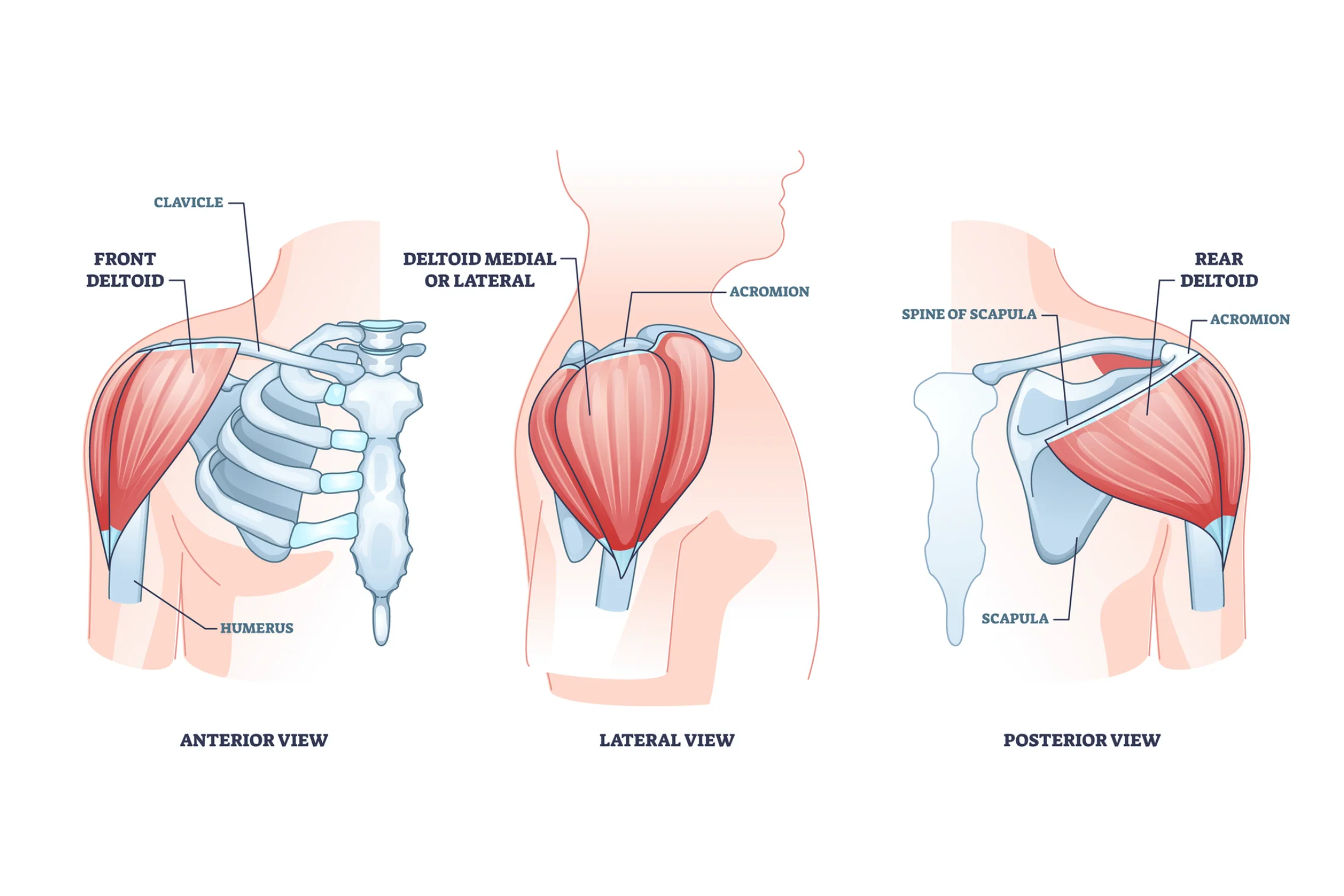
Let’s get into the structure and pivotal role of the middle deltoid muscle. Originating from the acromion process of the scapula, or the shoulder blade, this muscle extends to attach itself to the deltoid tuberosity on the humerus, the upper arm bone.
This setup is crucial for flinging your arms out to the side. Think about doing lateral raises at the gym—that’s your middle delts in action, pulling your arms away from your torso. This isn’t just a random flail; it’s a precise move called abduction, where you’re basically making a T with your body.
Beyond just their use in side delt specific exercises, the middle deltoids also support other shoulder muscles during various exercises. When you’re pushing weights above your head or knocking out push-ups, your middle delts are there too, backing up your front delts by keeping your shoulders steady and in check.
Understanding the significance of the middle deltoids helps us understand their dual contribution to both the aesthetic appeal of well-rounded shoulders and the functional strength required for comprehensive shoulder mobility. By focusing on targeted middle delt exercises for these muscles, you can enhance the overall performance and appearance of your shoulders.
The 9 Best Middle Delt Exercises to Build Muscle and Gain Strength
1. Dumbbell Lateral Raises
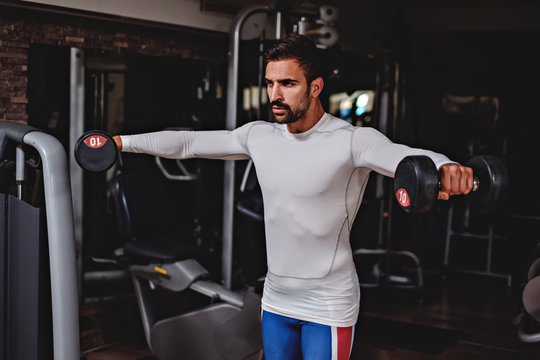
Perfect for sculpting the side silhouette of your shoulders, dumbbell lateral raises are a staple in shoulder development. They specifically target the middle deltoids, enhancing shoulder width and definition.
How to do it:
- Stand tall with a dumbbell in each hand, palms facing your body.
- Keep a slight bend in your elbows and maintain a straight back throughout the exercise.
- Lift the dumbbells laterally until they reach shoulder height, ensuring that your arms are parallel to the ground.
- Slowly lower the weights back down to the starting position.
- Repeat for the desired number of repetitions.
2. Cable Lateral Raises

Cable lateral raises ensure continuous tension throughout the movement, ideal for consistent stimulation of the middle deltoids. This exercise helps refine muscle tone and shoulder strength.
How to do it:
- Stand facing a cable machine with the handle attached to the low pulley.
- Grasp the handle with one hand and stand tall with your elbow slightly bent.
- Keeping your arm straight, lift the handle laterally until it reaches shoulder height.
- Slowly lower the handle back down to the starting position under control.
- Repeat for the desired number of repetitions before switching sides.
3. Barbell Upright Rows

Barbell upright rows target the middle deltoids, traps, and upper back muscles.
How to do it:
- Hold a barbell with an overhand grip, hands shoulder-width apart, and let it hang in front of your thighs.
- Stand tall with your chest up and shoulders back.
- Keeping the barbell close to your body, pull it upward toward your chin, leading with your elbows.
- Pause at the top of the movement, then slowly lower the barbell back down to the starting position.
- Repeat for the desired number of repetitions.
4. Seated Dumbbell Shoulder Press
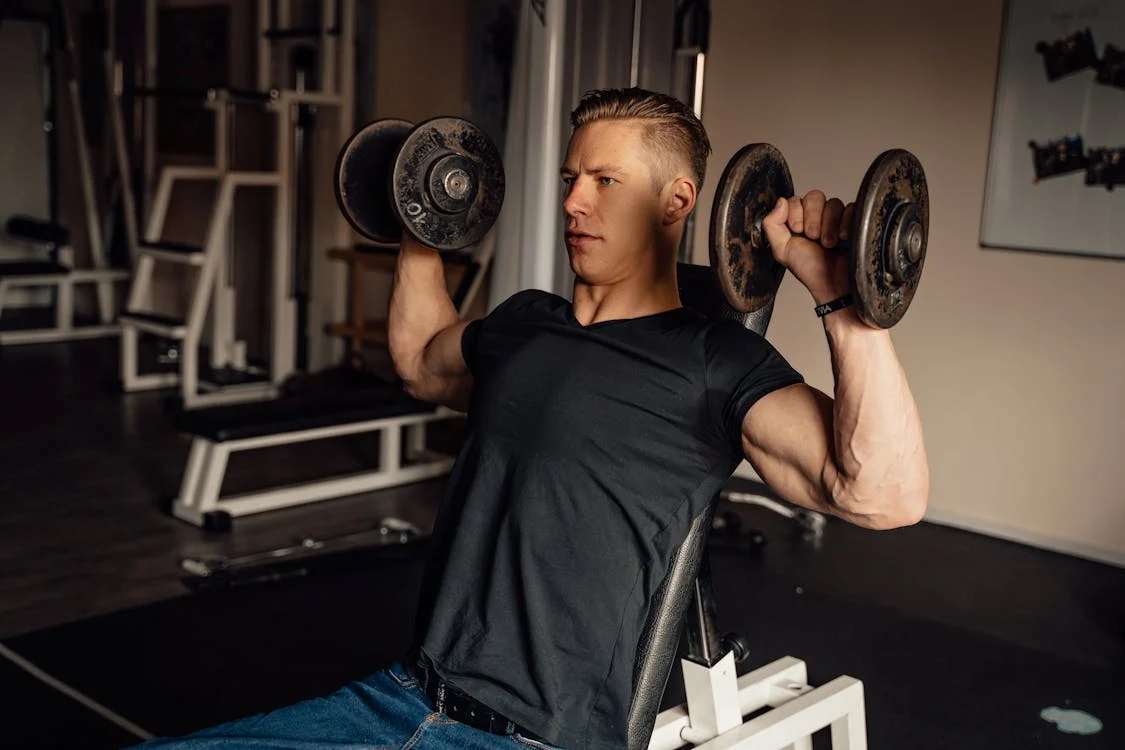
Seated dumbbell shoulder press targets the entire shoulder complex, including the middle deltoids. You can also do the standing dumbbell shoulder presses if you have no bench to sit on.
How to do it:
- Sit on a bench with back support, holding a dumbbell in each hand at shoulder height.
- Press the dumbbells upward until your arms are fully extended overhead.
- Keep your core engaged and avoid arching your back.
- Slowly lower the dumbbells back down to shoulder height.
- Repeat for the desired number of repetitions.
5. Arnold Press
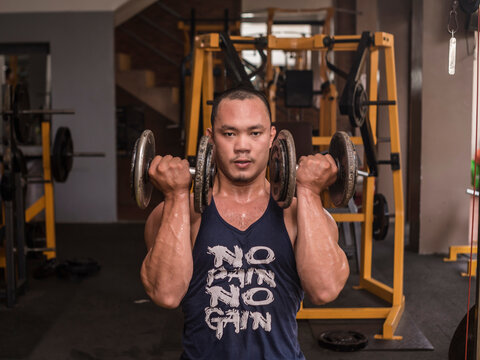
Named after the legendary Arnold Schwarzenegger, the Arnold press rotates to hit multiple angles of the shoulder, focusing intensely on the middle deltoids for well-rounded development.
How to do it:
- Hold a pair of dumbbells at shoulder height with your palms facing you.
- Press the dumbbells upward while simultaneously rotating your palms to face forward.
- Continue pressing until your arms are fully extended overhead.
- Reverse the motion by lowering the dumbbells back down to shoulder height while rotating your palms to face you again.
- Repeat for the desired number of repetitions.
6. Reverse Pec Deck Flyes

Reverse pec deck flyes isolate the rear delts but also engage the middle deltoids as stabilizers.
How to do it:
- Adjust the seat height on the pec deck machine so that the handles are at shoulder level.
- Sit facing the machine and grasp the handles with an overhand grip.
- Keep a slight bend in your elbows and maintain a neutral spine.
- Pull the handles backward until your arms are fully extended to the sides.
- Slowly return to the starting position under control.
- Repeat for the desired number of repetitions.
7. Cable Face Pulls

Cable face pulls target the rear delts and upper back muscles while also engaging the middle deltoids.
How to do it:
- Attach a rope handle to the high pulley of a cable machine.
- Stand facing the machine and grasp the handles with an overhand grip.
- Step back to create tension in the cable and position your feet shoulder-width apart.
- Pull the handles towards your face while keeping your elbows high and wide.
- Squeeze your shoulder blades together at the end of the movement.
- Slowly return to the starting position.
- Repeat for the desired number of repetitions.
8. Bent-Over Dumbbell Reverse Flyes
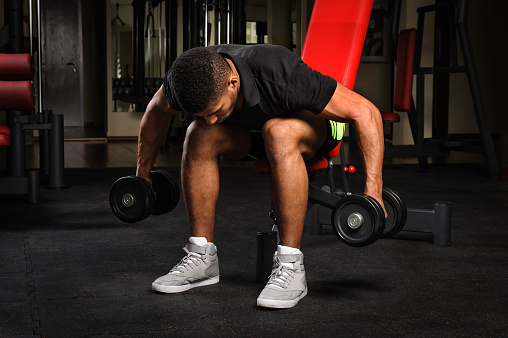
Bent-over dumbbell reverse flyes target the rear deltoids and also engage the middle deltoids and upper back muscles.
How to do it:
- Hold a pair of dumbbells in each hand and hinge forward at your hips, keeping your back flat and chest up.
- Let the dumbbells hang directly below your shoulders with your palms facing each other.
- Keeping a slight bend in your elbows, lift the dumbbells out to the sides until they reach shoulder height.
- Squeeze your shoulder blades together at the top of the movement.
- Slowly lower the dumbbells back to the starting position.
- Repeat for the desired number of repetitions.
9. Standing Cable Front Raises
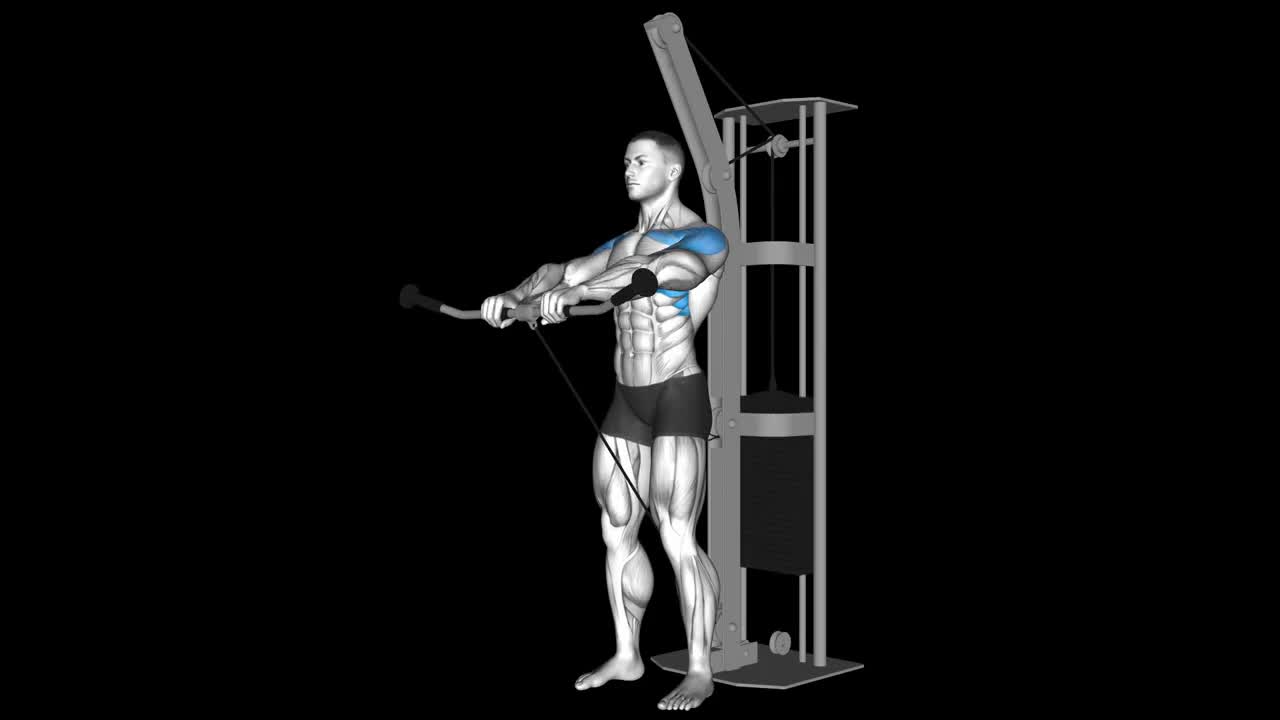
Standing cable front raises target the front and middle deltoids, helping to improve shoulder strength and stability.
How to do it:
- Stand facing a cable machine with the handle attached to the low pulley.
- Grasp the handle with one hand and stand tall with your arm extended downward and palm facing your thigh.
- Keep a slight bend in your elbow and maintain a straight back throughout the exercise.
- Lift the handle upward until it reaches shoulder height, keeping your arm straight.
- Slowly lower the handle back down to the starting position.
- Repeat for the desired number of repetitions before switching sides.
Specialized Techniques to Target Middle Delts
Partial Reps: Stimulating Middle Delt Growth

When it comes to achieving well-developed shoulders, incorporating specialized techniques like partial reps can be a game-changer for targeting those middle delts. Partial reps involve performing a movement within a limited range of motion, specifically focusing on the most challenging portion of the exercise. In the case of middle deltoids, partial reps can stimulate growth by increasing time under tension and forcing the muscles to work harder.
To apply this technique to middle delt exercises, you can try the “bottom-half lateral raise.”
Grab a pair of dumbbells with your feet shoulder-width apart and a slight bend in your knees. Lean forward slightly from your hips while keeping your back straight. Lift the dumbbells up but don’t complete a full lateral raise rep. Instead, lift until your arms form around a 45 degree angle, so you are only doing the bottom half of the rep.
By working within this limited range, you put maximum stress on the middle deltoid muscle fibers, promoting targeted growth.
Partial reps are an amazing move for after you complete a set of full reps to near failure. Try regular lateral raises, and once you can’t do any more, do a few partial reps. This way you are really working the muscles til exhaustion, and getting all you can out of each set.
Remember, partials are just one part of a broader strategy. Mix them into a routine that includes full-range moves like overhead presses and regular lateral raises.
Supersetting: Amplifying Middle Delt Development

Supersetting is another valuable technique that can take your middle delt development to new heights. It involves performing two exercises consecutively without taking any rest between sets. By combining specific exercises that target different aspects of the middle deltoids, you create an intense stimulus for growth.
One effective superset routine for developing broader shoulders involves pairing dumbbell lateral raises with upright rows.
Perform dumbbell lateral raises by raising your arms out to the sides until they are parallel to the ground. Maintain a slight bend in your elbows and focus on squeezing your middle delts at the top of the movement.
Immediately after completing the lateral raises, transition into upright rows.
Stand with your feet shoulder-width apart, holding a barbell or dumbbells in front of you with an overhand grip. Pull the weight upward by leading with your elbows, keeping them higher than your hands throughout the movement.
This exercise engages not only the middle deltoids but also other muscles such as the front delt and lateral delts.
Supersetting will not only save you time in the gym, but will increase the intensity of your lifts. It will have you constantly working but at the same time it gives one muscle group a slight rest while another one goes to work.
Sample Middle Delt Workout Routines
Here are two effective middle delt workout routines designed to target and strengthen your shoulder muscles:
Routine 1: Beginner Middle Delt Workout
- Dumbbell Lateral Raises: 3 sets x 12 reps
- Seated Dumbbell Shoulder Press: 3 sets x 10 reps
- Cable Lateral Raises: 3 sets x 12 reps
- Reverse Pec Deck Flyes: 3 sets x 12 reps
Rest for 60-90 seconds between sets.
Routine 2: Intermediate/Advanced Middle Delt Workout
- Barbell Upright Rows: 4 sets x 8 reps
- Arnold Press: 4 sets x 10 reps
- Bent-Over Dumbbell Reverse Flyes: 4 sets x 12 reps
- Cable Face Pulls: 4 sets x 12 reps
Rest for 45-60 seconds between sets.
These workout routines are designed to provide a balanced mix of exercises targeting the middle deltoids from various angles. Remember to choose weights that challenge you while maintaining proper form throughout each exercise.
Additionally, gradually increase the weight as you progress to continue stimulating muscle growth and strength gains. As always, listen to your body and adjust the volume and intensity of shoulder workouts according to your individual fitness level and goals.
Other Quick Tips and Tricks to Grow Middle Delt Muscles

Mix Isolation and Compound Movements:
During your shoulder workouts, you want to blend compound movements that target the entire shoulder with isolation movements that focus specifically on the middle delt. For example, do some shoulder pressing movements for overall development, mixed with lateral raises to really target the side delt.
Progressive Overload:
To stimulate muscle growth in the middle deltoids, it’s crucial to progressively overload the muscles over time. This means gradually increasing the weight, reps, or sets of your middle delt exercises to continually challenge your muscles and promote muscle hypertrophy (aka muscle growth).
Mind-Muscle Connection:
Focus on establishing a strong mind-muscle connection during your middle delt workouts. Concentrate on feeling the tension in your deltoids throughout each rep, and avoid using momentum or relying on other muscle groups to lift the weight.
Controlled Eccentric Movements:
Pay attention to the eccentric (lowering) phase of your middle delt exercises, as this is where muscle damage occurs and stimulates growth. Slow down the lowering portion of each rep, focusing on maintaining control and feeling the tension in your middle deltoids.
I promise you that if you do some lateral raises, and really focus on lowering the weight as slow as you can before lifting it back up, you will feel the burn 10x more than you would if you were just throwing around much heavier weight with no real tempo behind it.
Vary Your Grips and Angles:
Experiment with different grips and angles to target the middle deltoids from various perspectives. For example, using different angles during cable lateral raises or incorporating incline bench presses can shift the emphasis onto the middle deltoids and promote muscle growth.
Ensure Adequate Recovery:
Getting enough rest and recovery are crucial for muscle growth. Make sure to prioritize sleep, nutrition, and hydration to support muscle repair and growth. Additionally, consider incorporating active recovery techniques like foam rolling and stretching to alleviate muscle soreness and prevent injury.
By implementing these tips and tricks into your middle delt workouts, you can effectively stimulate muscle growth and achieve well-developed shoulders. Remember to stay consistent, listen to your body, and adjust your training routine as needed to continue making progress towards your fitness goals.
Conclusion
Focusing on the middle deltoids is more than just about enhancing your physique—it’s about creating a balanced foundation for your shoulder health and functionality.
By incorporating specific exercises that target this key area, you can build stronger, more resilient shoulders that look great and perform optimally in any situation.
Embrace the power of middle deltoid training to really transform your lifting routine and see huge results that completely change the look of your upper body.







